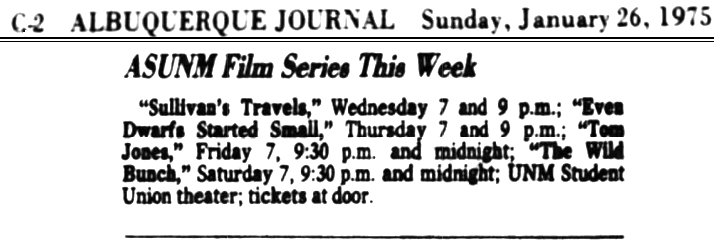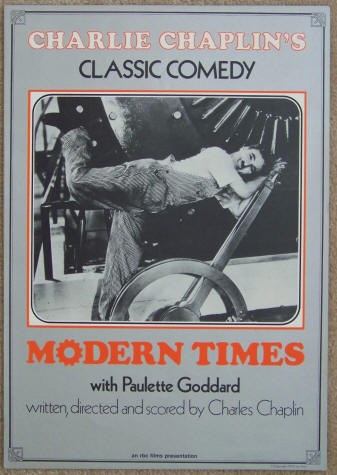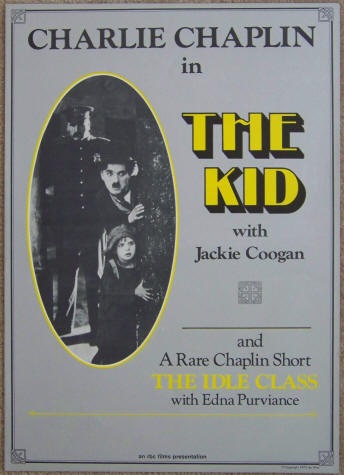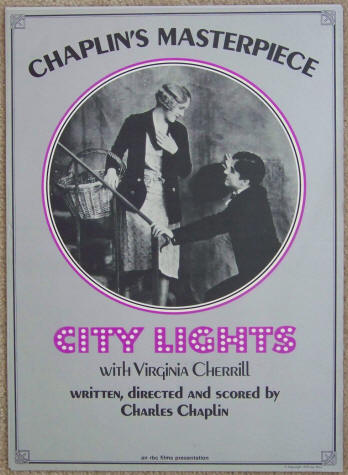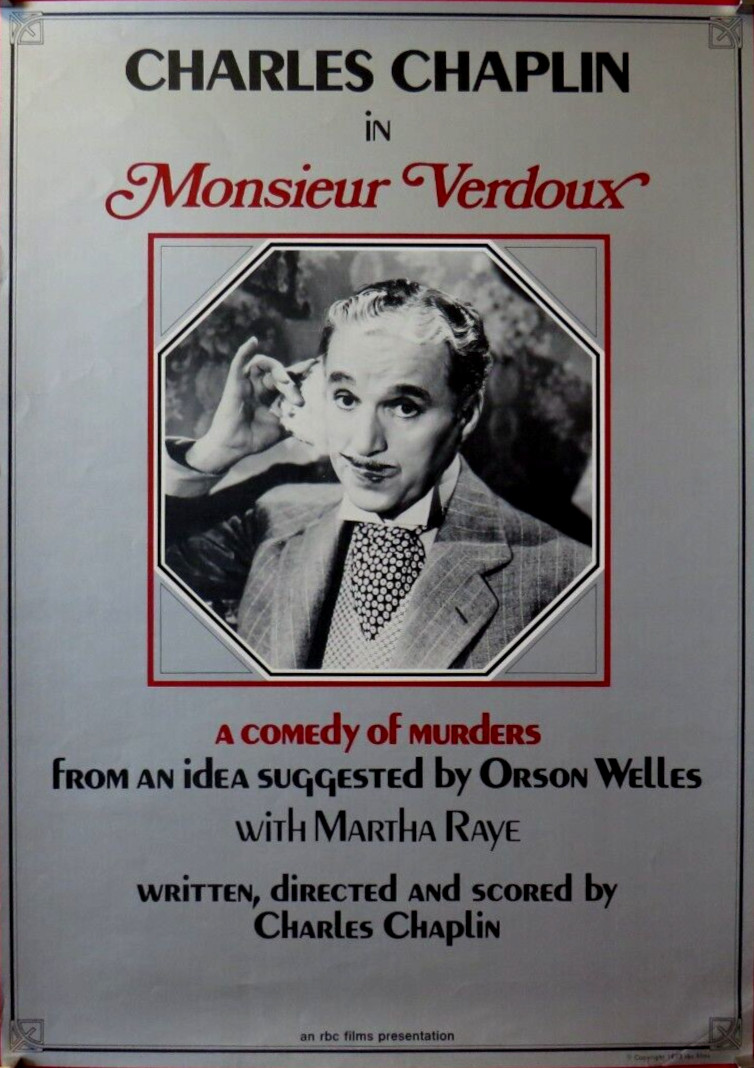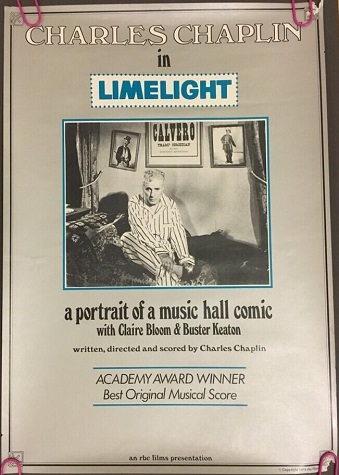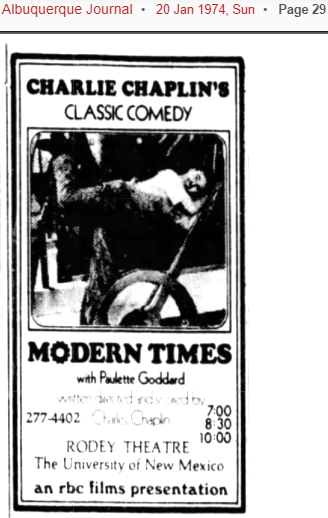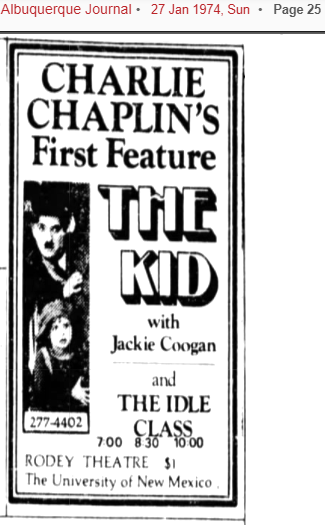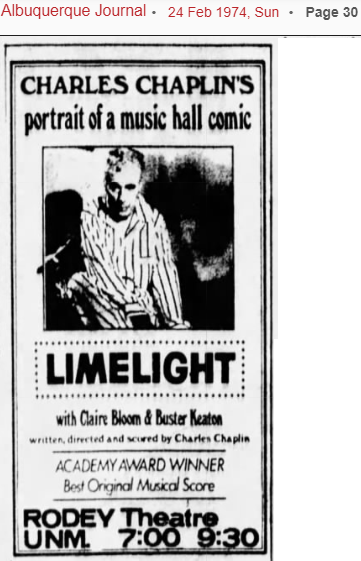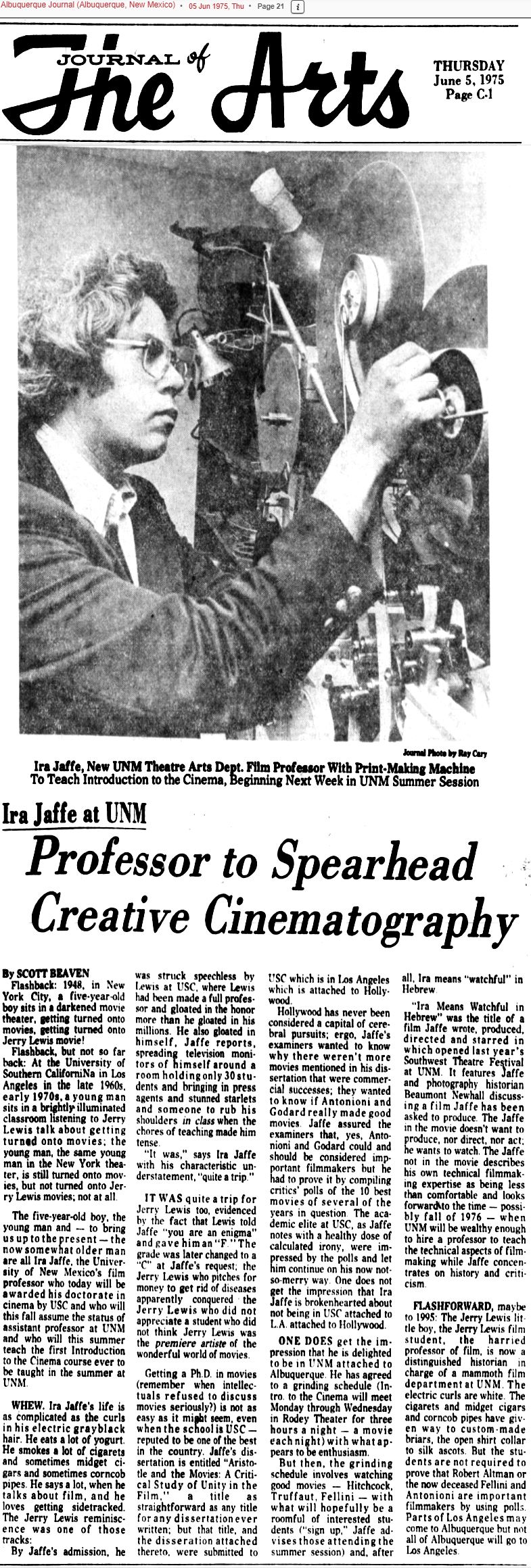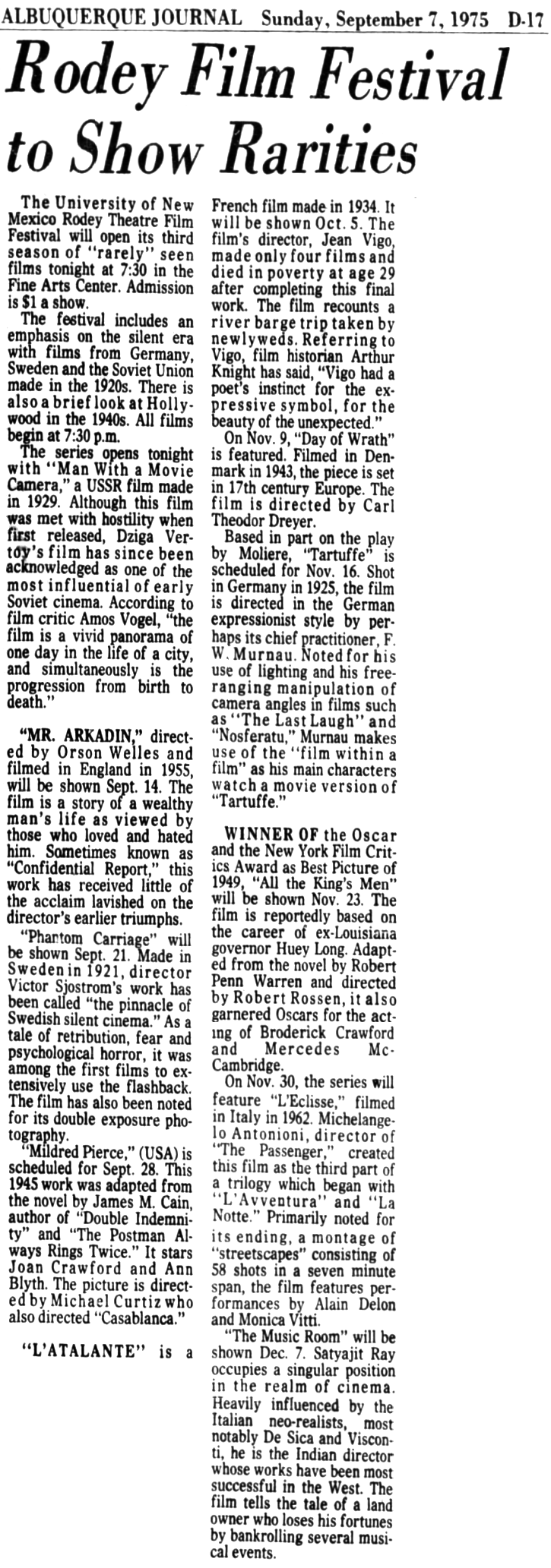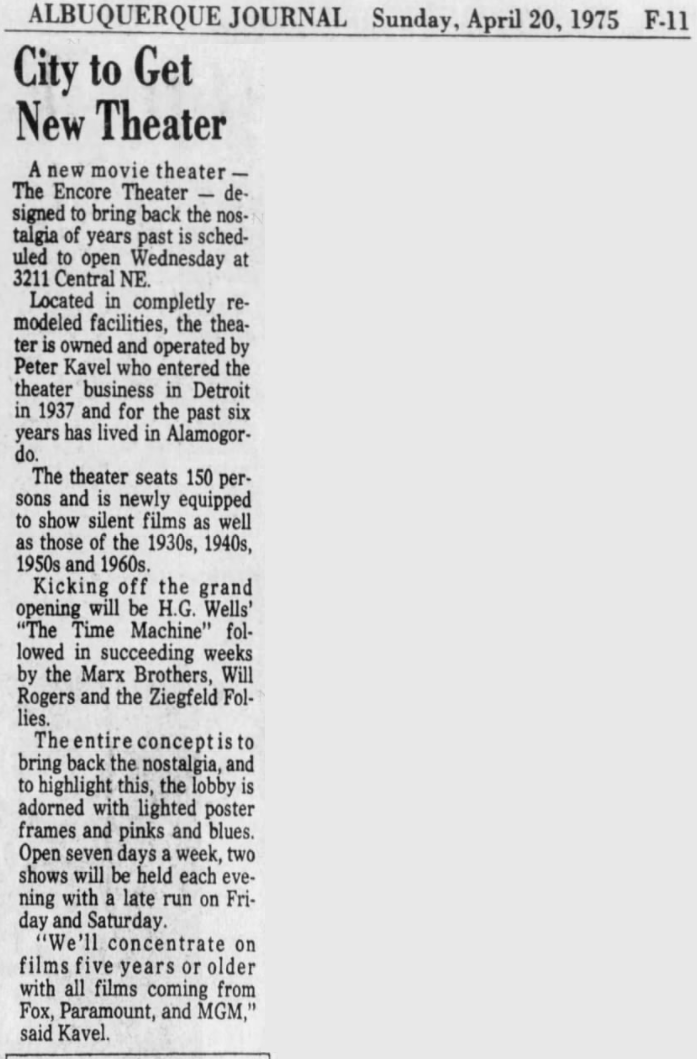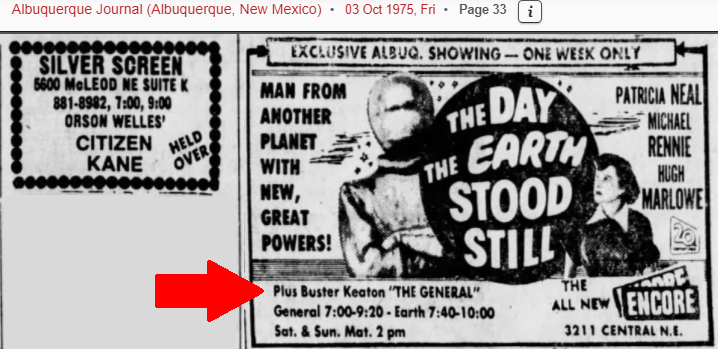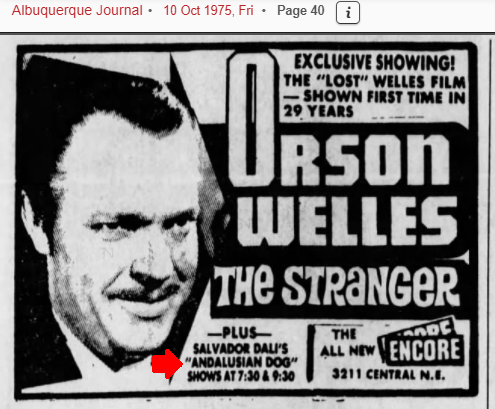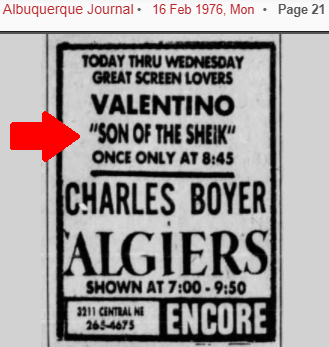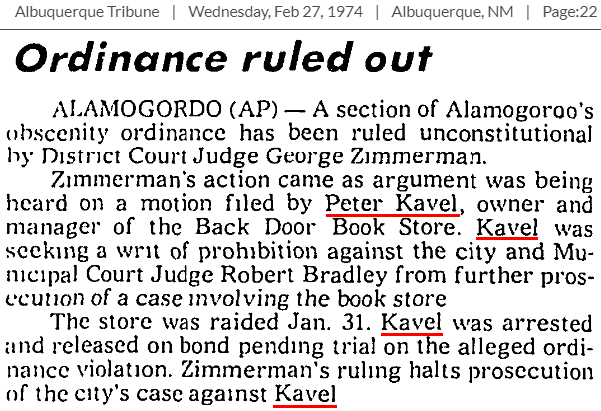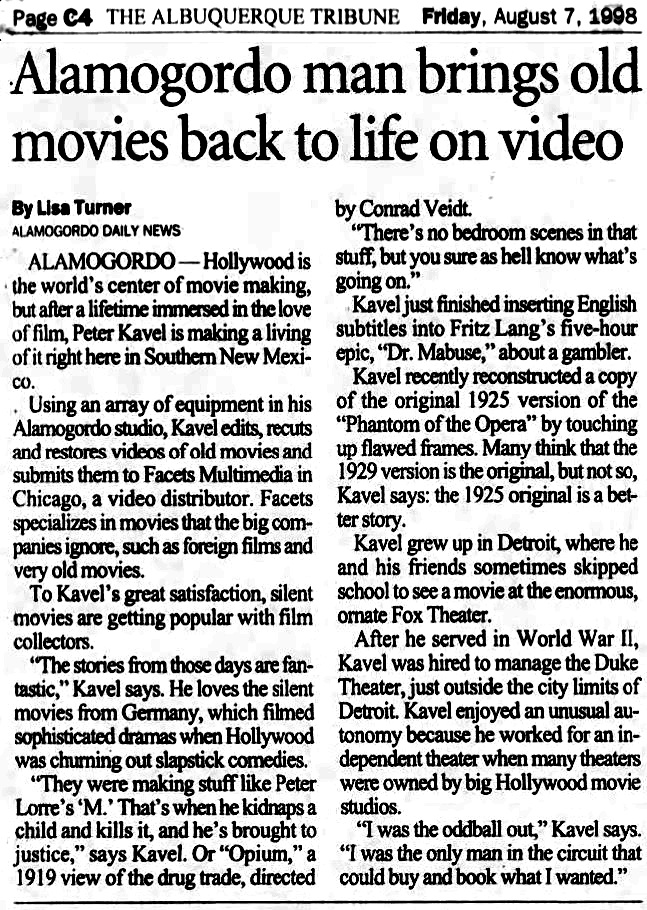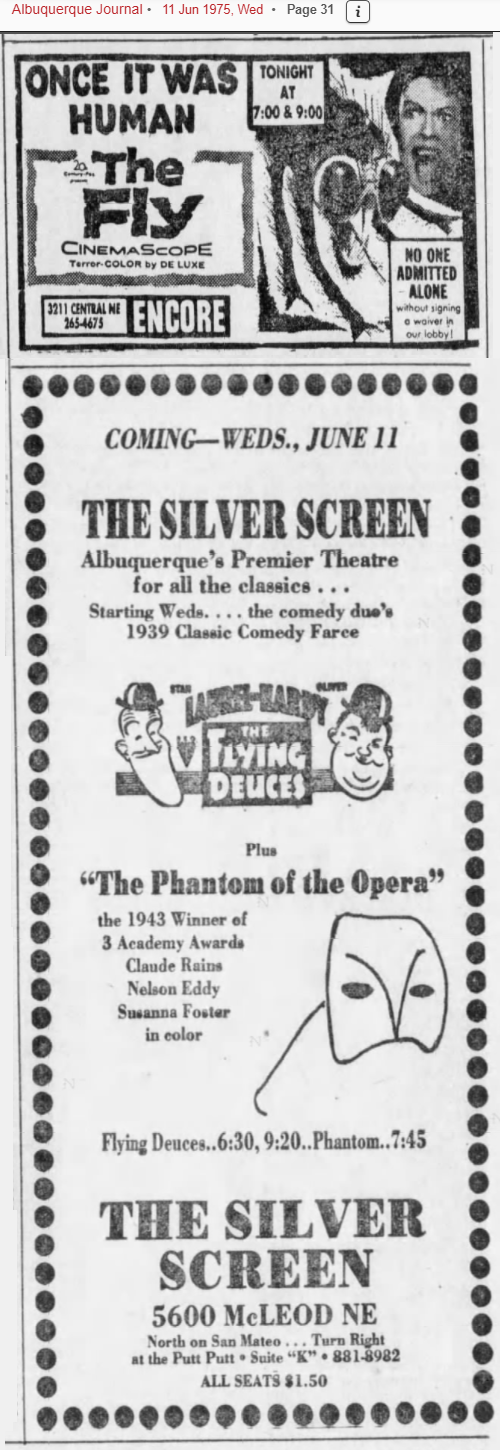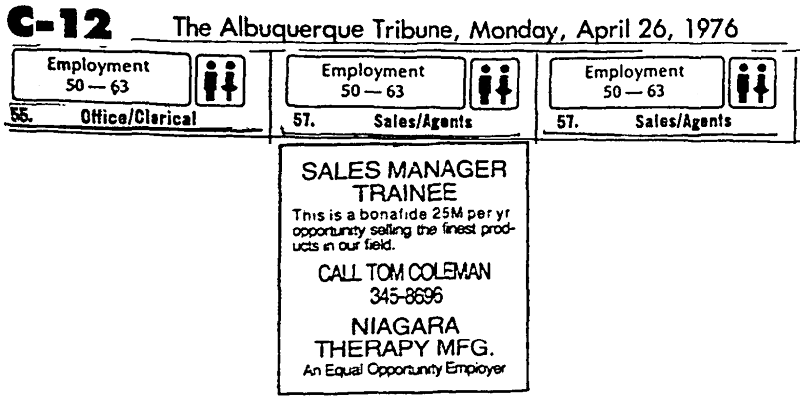Chapter 16
The Screening Room Twin
The Screening Room Twin
To the best of my recollection, Don Pancho’s was the second cinema in the Movie, Inc., chain.
In order to get booking clout, it is necessary to have a massive customer base,
and so Movie, Inc., decided to get a massive customer base.
It was time to purchase or lease other cinemas hither, thither, and yon, and to become the booking agent for yet others.
The owners of the First Plaza Galería Building in Albuquerque carved out a twin cinema in a part of its underground
(literally, underneath the ground, basement level) shopping center.
Few people ever knew about that hidden shopping plaza.
When I visited again a couple of years ago, there were still almost no customers inside.
Nothing has changed.
This new cinema was oddly shaped, because it had to squeeze into existing space.
I do not know who the architect was, but whoever it was designed it (predictably) for widescreen only, without masking.
In 1976, twin cinemas were still still a rather novel idea.
The First Plaza Galería executives apparently accepted bids for the space, and Movie, Inc., won.
That was a business blunder and I’m surprised it didn’t destroy Movie, Inc.
It certainly did a great deal of damage, though.
The Screening Room was one of the first cinemas in Albuquerque to use Christie
platters.
Monaural sound only, as one would guess, Century equipment, which everybody likes except for me,
because the framing mechanism is poorly designed and has limited range (3¾ sprockets instead of 4).
It also had Christie consoles, which did not make my heart flutter.
(They were something like
this.)
The two union guys adored Century and Mr. Master told me it was “the Cadillac of projectors.”
Mr. Riot Act had also told me, a year or so previously, that he preferred platters to change-overs.
Shall I hazard a guess that the equipment was part of the MPMO contract?
Mr. Master certainly hated cropping films and he erroneously thought that Academy 1:1.375 was as big as an image could get.
So, shall I hazard a guess that the setups for 1:1.375 and 1:1.66 were also a part of the MPMO contract, negotiated by Mr. Master?
Oddball twin cinema, each auditorium shaped like a wedge, with the screen at the tiny end of the wedge.
They might as well have just put a TV set in place of the screen.
Actually, now that I think about it, I’m not being fair.
The screens were quite large, but because they were at the small end of the wedge,
they gave the distinct appearance of being vanishingly small.
The Screening Room opened (Screen 1) with Bergman’s made-for-television
Magic Flute,
1:1.375 cropped pitilessly to 1:1.85.
I asked Mr. Riot Act to run it with the Academy aperture,
but he would not, saying that the Academy aperture was just “too small” on those microscopic little screens.
Yes, it was too small. He was right,
but still, I’d rather a picture be too small than cropped.
It was a horrible movie, horrible, horrible, horrible, and cloying and stupid, too.
Still, though, there is no excuse for cropping a movie, no matter how horrible it is.
(I am the only movie buff in the history of the universe who is not enamored of Ingmar Bergman’s works.)
Movie, Inc., worked its way out of the Screening Room lease after eleven weeks and two days.
Its last show was Sunday, 2 May 1976.
There was insufficient clientèle for oddball movies in a business district so far removed from the university,
in an invisible shopping mall literally beneath the ground that had relatively few visitors.
The financial strain must have been too great.
| Date | Screening Room 1 | Screening Room 2 |
| 13 Feb 1976 | The Magic Flute (1975, CROPPED) | Swept Away (1974) |
| 05 Mar 1976 | Three Days of the Condor (1975) | |
| 12 Mar 1976 | Sheila Levine Is Dead and Living in New York (1975) | |
| 26 Mar 1976 | The Godfather Part II (1974) | Emmanuelle: The Joys of a Woman (1975) |
| 02 Apr 1976 | Fat City (1972) Hard Times (1975) |
|
| 04 Apr 1976 | Shampoo (1975) Bob & Carol & Ted & Alice (1969; premièred at the Fox 25 Dec 1969) |
|
| 09 Apr 1976 | Banjoman (1975) | |
| 07 May 1976 | CLOSED | CLOSED |
Four art-house screens for Albuquerque?
Only a dreamer would have thought that might have worked.
I mean, Los Ángeles County, with a population of just under 10,000,000,
can barely support three small specialty/repertory houses,
two of which are nonprofit 501(c)(3)’s that rely on charitable donations and corporate sponsorships to survive.
Albuquerque at the time had a population of just under 250,000.
It was a backwater.
That it had even a single specialty/art/rep screen was little short of a miracle.
It is nearly unbelievable that a single specialty/art/rep screen could break even.
Now there was an attempt at four such screens?
Not only four. Five!
In January 1975, the ASUNM opened its doors to the general public
and allowed anybody to purchase tickets to its 16mm film programs at the Union Theatre in the Student Union Building (SUB).
The bulk of the films shown by the Film Committee were exactly what was shown at Don Pancho’s and The Guild,
and there was lots of second-run Hollywood stuff, as well.
In Chapter 55 I recount the story of the various film societies at UNM, which date back to 1940.
The story is much more interesting than I would have suspected.
Not only five. Six!
Remember the new Rodey Theatre that opened in 1973, which replaced the old condemned Rodey Theatre?
By January 1974 it was set up to show movies, and it began with a series of Chaplin films.
The booth was interesting.
The scene shop (I presume) built a pair of makeshift wooden stands
for a pair of portable Singer slotload projectors with xenon attachments stuck down the top.
These wooden stands were placed in the follow-spot booth and the audio jacks were wired to the sound booth next door.
When I attended the Chaplin films, there was a problem.
The height of the stands wasn’t quite right, and so a tiny smidgen of the top of the image landed on a lighting grid above the auditorium.
(I loved working on that lighting grid. It was like a trampoline.)
That was fixed up by 1979, maybe a bit earlier than that.
The focus knobs were either missing or broken, and so the projectionist focused by sticking the sharp end of a pocket-knife blade
into a groove on the lens casing and then gently moving it back and forth until the image was sharp.
The lenses were remarkably good, and despite the steep rake, the focus was quite sharp.
The Chaplin series was a hit.
Well, almost nobody showed up for the final film in the series,
Limelight,
but apart from that, the films were all hits —
and the screaming laughter was like nothing I had heard before or since.
The Rodey box office gave out mini-posters — 14"×20", silver, card stock — for each movie to everybody who bought a ticket.
For Limelight, though, posters were in short supply.
I was lucky enough to get one.
A young gal who was behind me in line was not so lucky.
She ended up falling in love with Limelight
(it’s very easy to fall in love with Limelight),
and as soon as the movie was over, she was desperately begging everybody for a poster.
She begged me for a poster, and, to my everlasting regret, I said No.
I wish I had just handed it to her and befriended her. Oh well.
Cruel irony: I think my collection of RBC Chaplin posters all vanished decades ago.
I suppose that, when I was away, my father decided to toss out more of my accumulated junk. So typical.
Who was in charge of these Chaplin screenings at the Rodey?
I never asked, and so I never found out.
The order form makes it clear that this series was put on
by the Department of Theatre Arts at the University of New Mexico,
but who at the Department was in charge?
That remains a mystery to me.
What is not a mystery to me is what followed the Chaplin series.
In September 1974, a new film instructor, Ira Jaffe, revived a defunct university student group called La Société du Cinéma
and began putting on an intermittent and irregular series at the Rodey on the few Sunday evenings that were not already booked.
Below is an article about him.
Now you can read an article about his second year of the film series:
In September 1974, Ira Jaffe revived La Sociètè du Cinèma
and began booking specialty films at UNM’s Rodey Theatre.
This was the 16mm “Rare Film” series.
(Tom Hysom, “Drama,
Dance, Film Boost UNM Theater Fall Season,” Albuquerque Journal
vol. 94 no. 250, Sunday, 7 September 1975, p. D-14 .)
Ira’s choices were wonderful.
He kept the series running intermittently from September 1974 through sometime in 1987.
For whatever it’s worth,
this was the Albuquerque première of the 1929 film,
Man with a Movie Camera.
This was also the Albuquerque première of the authentic version of
The Phantom Carriage,
over 54 years after its release.
Well, what was the rush?
Actually, it had been shown in Albuquerque earlier, yes, but in a mutilated version entitled
The Stroke of Midnight,
which played at the (second) Lyric for all of two days,
1 and 2 December 1922, and then it was gone for good.
The film was afterwards entirely unavailable, and only a few incomplete copies survived.
In 1975, some archivists in Sweden hammered all those fragmentary copies back together
and, as luck would have it, all the pieces were there, somewhere in the mix.
They had a complete movie again!
It was that fresh restoration that Ira booked at the Rodey.
Further, this was also the Albuquerque première of
Tartuffe, a mere 49 years after its original release.
I’m pretty sure this was also the first Albuquerque showing of
The Music Room,
which had been released 16 years earlier.
L’Atalante had been shown at UNM in earlier years,
and Moving Pictures Ltd had once presented it at The Guild,
but it has never, to my knowledge, had a commercial booking in Albuquerque.
Exactly the same applies to Day of Wrath.
The Rodey was doing yeoman’s work, and I so much wanted to attend, but that road was blocked.
Not only six. Seven!
On 23 April 1975, Peter Kavel of Detroit converted the Mini Vue into a rep/art house called the
Encore.
Just as the Mini Vue, a stone’s throw from The Guild, had sought in 1969 to siphon off The Guild’s porn crowd,
now the Encore, in 1975, sought to siphon off The Guild’s artsy crowd.
With nearly four decades of experience behind him,
Peter Kavel knew to install the correct formats (including silent!!!!),
but it becomes clear that he did not know how to cultivate an audience.
He failed, very quickly.
Less than two years later, he shut down.
Now that I review the ads, I think I can piece the story together.
Peter did not have the most exciting schedule, to say the least.
His newspaper ads were sloppy and ugly.
Take a look for yourselves.
He did not have his ear to the ground.
He was not catering to the Albuquerque audience.
He was simply running the movies he had enjoyed when he was a kid,
under the misapprehension that if he liked them, everybody else liked them too.
He thought all he needed to do was run display ads in the paper and people would flock in.
He did not understand that Errol Flynn swashbucklers had had their day,
that Shirley Temple flicks had had their day, that these blasts from the past were no longer hot items and would never fill the house.
I would guess that those titles sold probably no more than five or ten tickets each.
Out of desperation, he switched his programming to more modern films, but only the ones most cheaply available.
I didn’t think the Encore had ever run a silent film, but I was wrong.
The Encore ran
The General for a week beginning on
Friday, 3 October 1975,
with an ad so unnoticeably small that I didn’t notice else I would have been there.
Then there was another the following week,
An Andalusian Dog,
again with an ad so small that I did not notice.
To my astonishment, there was even a third,
The Son of the Sheik,
for three days beginning
Monday, 16 February 1976!
And I didn’t notice! Darn it! Darn it! Darn it!
Perhaps those were the only times that Peter Kavel could find an accompanist?
He also brought in Battleship Potemkin and
Nosferatu, but with canned music.
Ditto with
The Kid,
The Circus, and
The Idle Class for a week beginning on 13 October 1976.
Oh! Look at this! I just learned something about him:
Peter Kavel, 7 November 1922 (East Prussia) – 4 July 2007 (Alamogordo).
Not only seven. Eight!
The Silver Screen was doomed. It was a dark, uninviting, empty room in a small office in a strip plaza in the middle of nowhere,
with a bedsheet as a screen and films run on 16mm portable Bell & Howell machines with 1000W incandescent lamps
in a makeshift plyboard projection booth.
Wrong location, wrong technology, wrong everything.
Nice people, definitely, really nice people, but they didn’t know what they were doing.
Was there yet another? Of course there was!

Do you see the problem? Captain Blood at the Encore had played at Don Pancho’s, twice, and it and The Dawn Patrol were scheduled to reappear at the Sunshine. Too many screens, too little product. Too many seats, too few customers. How many seats? 150 at the Encore + 153 at The Guild + 238 at Don Pancho’s + about 600 at the Sunshine (would have been about 900, but the balcony was closed) = a little over 1,100, to which we need to add the 180 seats at the SUB and the 442 seats at the Rodey. So, about 1,700 seats altogether.
Yes, as you can see above, there was indeed yet another attempt, despite the recent failures, and it was the most grandiose of all.
When Commonwealth declined to renew its lease for the Sunshine downtown,
the owner, Francis A. Peloso, decided to go it alone and reopened his Sunshine on
26 September 1976.
After all, he had been in the business all his life and he thought he could attract new crowds.
Alas, he could not.
Downtown had been a hopping place for eighty-eight years, but then, in 1970,
City Hall colluded with real-estate developers to kill it dead.
This was part of an ongoing fraud called “urban renewal.”
They bulldozed 90% of downtown and so there was no further incentive for people to visit.
That, in fact, is why Commonwealth had declined to renew its lease.
Downtown, in an instant, was no longer the commercial center of Albuquerque, but was instead a dead wasteland.
Mr. Peloso discovered that, regardless of a single cinema that might be presenting nice movies,
nobody wanted to go to a dead wasteland.
Herculean efforts were begun in 1977, courtesy of Mayor David Rusk, to undo some of the damage,
and so there is now a tiny trickle of life downtown, an aftereffect of his administration’s efforts,
but unless replicas of all the demolished buildings are constructed and unless all the uprooted business owners are reinstated, with reparations,
downtown will never again be a destination spot for shopping and entertainment.
Despite his experience, his intelligence, his best intentions,
Mr. Peloso was trying to appeal to a crowd that had died off, had moved away, or had been entirely alienated.
Like Peter Kavel at the Encore, Mr. Peloso simply ran the movies he knew from his youth.
It did not occur to him to select movies that Albuquerque audiences would be especially excited to see.
Maybe Mr. Peloso could have compensated for these problems somewhat if he had been sociable, amiable, if he had made friends with his audience.
But no, he was suspicious, taciturn, and he eyed everyone who came in because he seemed to think every customer was a vandal and a thief and a troublemaker.
There was thus no warm, inviting atmosphere at the Sunshine.
Instead, it was coldly impersonal.
Nobody was put off by him, but nobody wanted to visit with him, either.
If anybody had, he would not have allowed it, anyway.
That was a major failure.
People become regulars when they say to themselves, “Hey, we haven’t been to Frank’s place lately.
Why don’t we all go over and say Hi to him and watch some good movies?”
That sort of warmth might have made the Sunshine a success.
Maybe.
Unable to attract customers, he shut down three years later, and his last show was on 12 July 1979.
Did he lose money on the venture? I wish I knew.
My guess is that he lost nothing, but that he made nothing either.
After all, the Sunshine Building consists of six stories of rental spaces.
He probably did all right with the rental income.
When he gave up on his own programming, he
leased the theatre portion of his building to Luna Theaters of Plainview, Texas.
The new operators ran Méxican films and they packed the place to the rafters.
That surprised me.
Who on earth would go downtown to see a movie?
Well, Méxicans would!
Who’d a thunk it?
Those were fun movies and those were fun crowds, but then, in a flash, in 1988, Méxican film production stopped,
and that was the end of that.
Yes, the programming at the various specialty houses was somewhat different.
Donald Pancho’s gave itself lots of leeway to cater to whatever might catch the fancy of the artsy crowd.
The Guild concentrated on newer oddball films.
The Encore concentrated on more eclectic Hollywood stuff, the flicks that had once been mainstream but that had evolved into specialty items.
The Rodey concentrated on older films, especially foreign ones, that got little or no play elsewhere.
The SUB largely copycatted Don Pancho’s, but it also presented silent films and underground films that could not be seen elsewhere.
The Sunshine concentrated on Hollywood nostalgia.
What they all had in common was the audience.
The audience that likes one of these seven categories also likes the other six.
All these cinemas shared exactly the same audience, and that audience was small, really small, far too small to support more than one cinema.
In my foolish youth,
I was entirely convinced that the only reason the audience was small was because few people had had the opportunity to experience these films.
I was certain that if modern audiences could see the better Laurel & Hardy movies, the better Marx Brothers movies, the better Buster Keaton movies,
the better Charlie Chaplin movies, they would be won over, they would love the experience,
they would get hooked on these gateway doses, which would lead them to seek out more.
Wrong! People like only what is familiar to them, what they enjoyed between ages 13 and 23.
Anything different is confusing, anything older is stupid, and anything newer is junk.
I dread the day, 20 or 30 years hence, when not a single person on the planet enjoys any of this stuff.
I do not want to live to see that day.
I kept going to Donald Pancho’s and The Guild every couple of Saturdays.
Maybe five or six times Mark Brown waved me in.
I would so love to chat with Mark again.
That brings up another bad memory: My memory is that I attended quite frequently.
Nope. My review of newspaper ads combined with memories and notes reveals that I attended once in 1972, thrice in 1973, four times in 1974,
ten times in 1975, thirteen times in 1976, seventeen times in 1977, and five times in 1978.
Add to that my 13 apprentice sessions in 1975/1976 and the 34 shifts I worked in 1978.
I also dropped by to say Hi six times at The Guild and six times at Don Pancho’s.
That was enough to drive the staff there nuts.
Why did I think I was constantly in attendance, an irritation, like a persistent fly that nobody could manage to swat away?
Because Mr. Riot Act, his mom, and the concessionaire he lusted after
were sick and tired of me and got pained expressions on their faces whenever they saw me walk up.
At the time, I really liked all three of them and was hoping to smooth things over.
I was so naïve.
So, I now realize that it was the guilt that I felt that made me think I was barging in all the time, wearing out my welcome, taking advantage.
Now, nearly half a century later, I am somewhat relieved to discover that I was not barging in all the time after all.
I noticed that all the guys went gaga over a pretty blonde projectionist who had just been hired.
Chris was her name.
She was visibly annoyed at all the attention she was getting,
and as soon as she saw me, she gave me a stare that I recognized: Keep away! is what it said.
I kept away.
We never even said Hello.
That was around December 1977.
I say that because my memory is that she projected
Idi Amin Dada: Self-Portrait on 10 December 1977,
and I remember that I realized I should not pop into the booth to say Hi.
She was gone just a few weeks later.
I cannot remember her surname, darn it!
Yes, after all these decades, I would love to chat with her.
So, Chris, if perchance you stumble upon this page, please
drop me a note. Thanks!
Text: Copyright © 2019–2021, Ranjit Sandhu.
Images: Various copyrights, but reproduction here should qualify as fair use.
If you own any of these images, please contact me.
Images: Various copyrights, but reproduction here should qualify as fair use.
If you own any of these images, please contact me.

